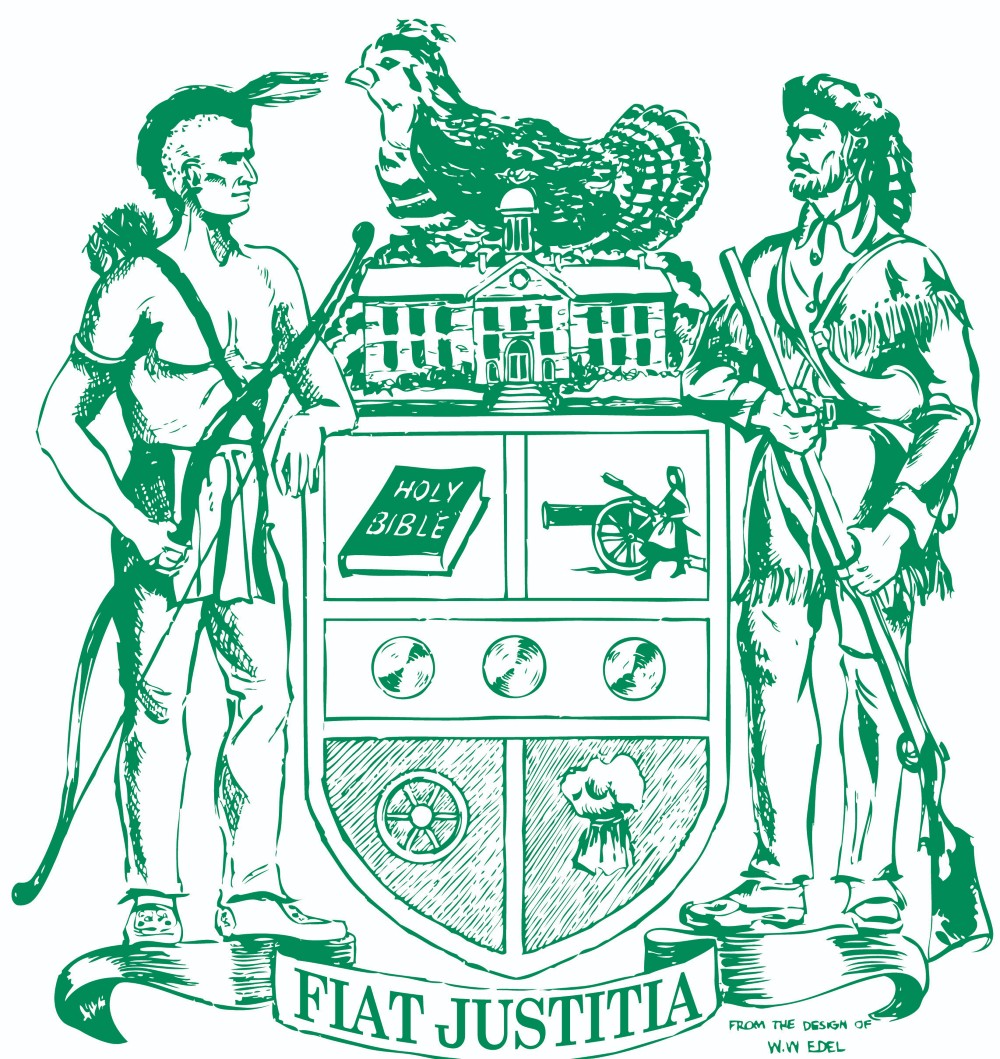
- Details
- By Jenna Kunze
The borough of Carlisle, Pennsylvania, voted last week to retire its logo depicting a crest flanked by a white man holding a rifle and a Native American man holding a bow and arrow above the Latin words Fiat Justicia meaning “Let justice be done.” Mayor Sean Shultz said the decision, reached last Wednesday in a unanimous borough council workshop, came from the realization that the current crest “has a naïve view of the relationship between Native Americans and westerners in this country, and specifically this area.”
Carlisle Indian Industrial School, founded in 1879 just three miles outside of downtown Carlisle, was the nation’s flagship boarding school that served to “kill the Indian save the man.” In its 39 years of operation, records show that at least 7,800 Native children attended Carlisle, and at least 194 died there from sickness, abuse, and neglect.
While Shultz said the internal discussions about a logo change came prior to the discovery of a mass grave of 215 Native children at the site of a former residential school in Canada. The discovery sparked the United States to take its own critical look at its Indian boarding school history. “But I would say that there's a sense of greater urgency because of those events,” he told Native News Online.
According to Shultz, a new logo has not yet been decided upon, and will include community input.
The original crest was designed by the president of the local Dickinson College in the 1950s to present upon gifts for a trip to the town’s namesake, Carlisle, England. The crest was never formally adopted by the local government, Shultz said.
“The importance of this is really two-fold,” Shultz said. “One is to recognize the way the crest objectifies Native American representation. And two, that it's time to move forward, and to have something that's more reflective of where we are and where we want to go as a town.”
Carlisle Indian Industrial School buried the bodies of at least 194 Indigenous children in the school cemetery, including 14 of whom are interred with “unknown” grave markers.
Since 2017, several tribes have engaged with the Army and instigated the return of their ancestors' remains. The U.S. Army continues to oversee the site’s graves of 173 remaining Native children.
This article has been updated to correct the spelling of Mayor Shultz's name and to clarify the vote was unanimous. It has also been updated to include Eleanor Hadden's comments.
More Stories Like This
Native News Weekly (August 25, 2024): D.C. BriefsUS Presidents in Their Own Words Concerning American Indians
Oral History Project Announces 14th Stop in Portland, Oregon: NABS Continues to Gather Crucial Stories Across Indian Country
Next on Native Bidaské: Telling the Untold Native Stories of the American Revolution
Native American Nearly Deported After Polk County jail Issues ICE Detainer by Mistake
Help us tell the stories that could save Native languages and food traditions
At a critical moment for Indian Country, Native News Online is embarking on our most ambitious reporting project yet: "Cultivating Culture," a three-year investigation into two forces shaping Native community survival—food sovereignty and language revitalization.
The devastating impact of COVID-19 accelerated the loss of Native elders and with them, irreplaceable cultural knowledge. Yet across tribal communities, innovative leaders are fighting back, reclaiming traditional food systems and breathing new life into Native languages. These aren't just cultural preservation efforts—they're powerful pathways to community health, healing, and resilience.
Our dedicated reporting team will spend three years documenting these stories through on-the-ground reporting in 18 tribal communities, producing over 200 in-depth stories, 18 podcast episodes, and multimedia content that amplifies Indigenous voices. We'll show policymakers, funders, and allies how cultural restoration directly impacts physical and mental wellness while celebrating successful models of sovereignty and self-determination.
This isn't corporate media parachuting into Indian Country for a quick story. This is sustained, relationship-based journalism by Native reporters who understand these communities. It's "Warrior Journalism"—fearless reporting that serves the 5.5 million readers who depend on us for news that mainstream media often ignores.
We need your help right now. While we've secured partial funding, we're still $450,000 short of our three-year budget. Our immediate goal is $25,000 this month to keep this critical work moving forward—funding reporter salaries, travel to remote communities, photography, and the deep reporting these stories deserve.
Every dollar directly supports Indigenous journalists telling Indigenous stories. Whether it's $5 or $50, your contribution ensures these vital narratives of resilience, innovation, and hope don't disappear into silence.
 The stakes couldn't be higher. Native languages are being lost at an alarming rate. Food insecurity plagues many tribal communities. But solutions are emerging, and these stories need to be told.
The stakes couldn't be higher. Native languages are being lost at an alarming rate. Food insecurity plagues many tribal communities. But solutions are emerging, and these stories need to be told.
Support independent Native journalism. Fund the stories that matter.
Levi Rickert (Potawatomi), Editor & Publisher

